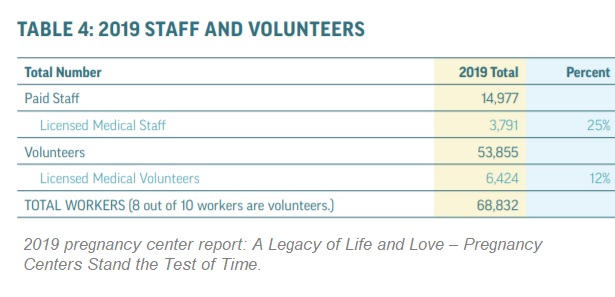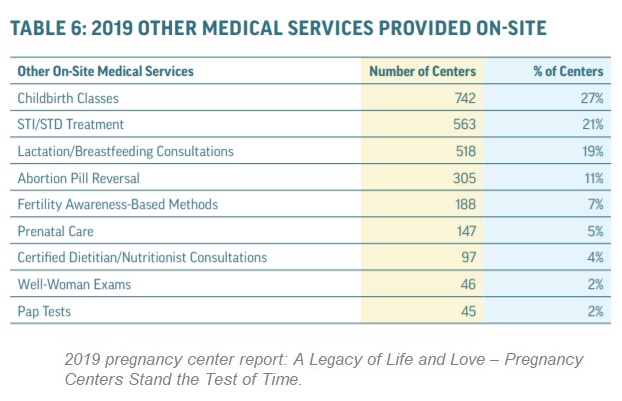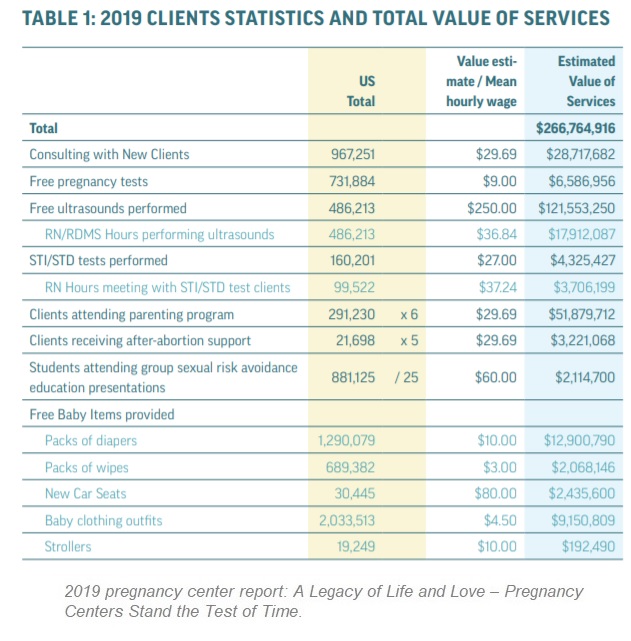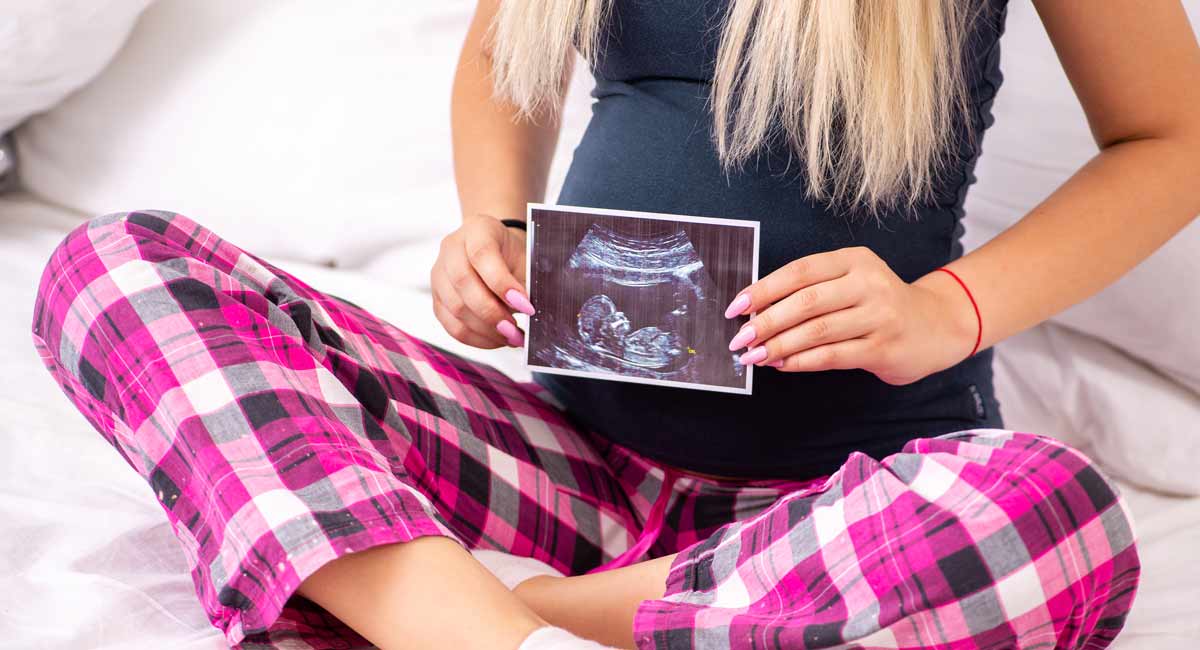The Charlotte Lozier Institute (CLI) has just released its latest study on the impact of pro-life pregnancy resource centers (PRCs). “Pregnancy Centers Stand the Test of Time” is based on national survey data provided by Care Net, Heartbeat International, and the National Institute of Family and Life Advocates as well as several smaller networks. It noted that a growing number of PRCs are now considered medical pregnancy centers/clinics and many medical workers are now among the tens of thousands of staff and volunteers at PRCs.
Number of pro-life pregnancy centers increased
In 2019, 2,700 pregnancy centers were represented in CLI’s report, up slightly from a previous analysis for 2017, which identified only 2,600 PRCs. PRCs identified in the 2019 report provided approximately 1.85 million people in the United States with free services, for an estimated total value of services at over $266 million.
“A higher number of “smaller” pregnancy centers seeing lower numbers of clients/patients participated in the 2020 survey process. This was reflected in lower totals in some client statistics categories in the 2019 results as compared to the 2017 results,” the report states.
In 2019, 23% of clients who received pregnancy testing services at pregnancy centers received a negative test.
Medical center growth
The number of medical pregnancy centers or clinics in the U.S. continued to grow, from 50 in 1998 to 2,132 in 2019. These included medical mobile units, sometimes called mobile clinics, which provided a confidential meeting and clinic space for the provision of pregnancy testing and limited pregnancy confirmation ultrasounds (and more) on board a comfortably designed vehicle which travels to designated locations.
The report states that in 2019…
- 79% (2,132) medical pregnancy center/clinic locations, including medical mobile units, provided 486,213 free limited obstetrical ultrasound scans (up from 76% of total centers providing ultrasounds in 2017). The estimated value of these ultrasounds was over $139 million.
- “[O]ver 120 Medical Units (MU) provided services to women and men in at least 37 states.”
- “ICU Mobile and Save the Storks provided services to over 7,300 clients… with 5,206 choosing life for their baby…”
PRC staff and volunteers
The number of paid staff, including medical specialists, has been steadily increasing at PRCs, according to the report. In 2019, nearly 69,000 pro-life staffers and volunteers joined together under a single mission to assist women and men before, during, or after pregnancy. This included 47,431 non-medical personnel who volunteered their time.
Over 10,000 licensed medical workers provided care at PRCs as either paid staff or volunteers. This amount reflects that 25% of the paid staff and 12% of the volunteer staff were medical workers. These credentialed individuals provided “ultrasounds, medical exams, STI/STD testing and treatment services, well-woman exams, fertility awareness-based education, prenatal care, lactation/breastfeeding consultations, and more,” the report states.

2019 Charlotte Lozier Institute (CLI) Pregnancy Center Report staff and volunteers
Funding for pregnancy resource centers
A small percentage of government funding (17%) was provided to pregnancy center organizations or main centers while at least 90% of total PRC funding was raised through private donations. Additional funding (less than 1%) came from Medicaid for reimbursement for STI/STD testing and treatment, pregnancy care services and well-woman exams. Title X funding allocated to PRCs for FY 2019 “received less than 0.7 percent of the total funds awarded to eight pregnancy centers as subgrantee service sites out of 4,000 service sites, representing only 0.2 percent of all Title X participant service sites,” the study noted.
In addition, the report states, “Pregnancy centers and/or adoption agencies in 29 states and the District of Columbia are eligible to receive funding through Choose Life license plates. ”
Services provided by pregnancy resource centers
The largest demographic to access services at sPRC in 2019 were women, who made up 80% of PRC clientele. Men made up just 20%.
In 2019, PRCs provided services which included:
- Almost 732,000 pregnancy tests
- More than 486,000 free ultrasounds
- Approximately 160,200 STI/STD tests
- Parenting and prenatal education programs for more than 291,000 clients
- After-abortion support for more than 21,000 clients
- Sexual risk avoidance education presentations for more than 881,000 students
- Nearly 1.3 million packs of diapers
- More than two million baby outfits
The percentage of centers offering the following services were:
- 94% provided material items like diapers, car seats, strollers, etc.
- 85% provided parenting/prenatal education
- 79% provided ultrasounds
- 72% provided after-abortion recovery
Abortion pill reversal (APR) is now offered in 11% of all PRCs, and as of the end of 2019, over 1,000 infant lives have been saved by the protocol. In addition, a growing percentage of centers offer sexual risk avoidance presentations to youth (36%), STI/STD testing (30%), STI/STD treatment (21%), childbirth classes (27%), and breastfeeding consultations (19%), along with well-woman and pap tests (2%), according to CLI’s press release.
READ: Five reasons why everyone should love pregnancy resource centers

2019 Charlotte Lozier Institute (CLI) prolife Pregnancy Center Report Other Medical Services
According to the report, in 2019:
- “A total of 160,201 STI/STD tests were performed on 99,522 clients (80,012 women and 19,510 men), at an estimated value of $8,031,626…”
- “[A] total of 291,230 clients participated in parenting education programs at pregnancy centers. Of these, 252,435 were women and 38,795 were men. [86%] of centers, or 2,312 centers, offered this type of parenting and prenatal education programming.”
- “The estimated value of the parenting programs in 2019 is $51,879,712.”
- 94% of centers (2,525 center locations) in the U.S. offered material assistance to parents. “These centers provided the following baby items: 1,290,079 packs of diapers, 689,382 packs of wipes, 2,033,513 baby clothing outfits, 30,445 new car seats, and 19,249 strollers.”
- The estimated value of material assistance in essential baby items is $26,747,835.
- “[A]pproximately three out of four pregnancy center locations (72%), or 1,931 center locations, provided after-abortion recovery and support to 21,698 people (21,201 women and 497 men).”
- “The estimated value of after-abortion recovery and support service is $3,221,068.”

2019 Charlotte Lozier Institute (CLI) prolife Pregnancy Center Report Value of Services
The report also indicated that five percent (147 pro-life pregnancy center locations) offered some level of prenatal care “beyond the provision of prenatal vitamins on-site.” In contrast, undercover investigations conducted by Live Action have revealed that abortion — not prenatal care — is the primary service Planned Parenthood offers to pregnant clients. In past 10 years (2010 to 2018) at Planned Parenthood prenatal care has dropped 68%.
PRCs have also expanded outreach for victims of human trafficking, assisted clients challenged with opioid addiction, and helped women and men struggling with past abortion experiences through abortion recovery. They have also provided safe and stable maternity homes for women.
Today, the 2,700 pro-life pregnancy resource centers vastly outnumber the 1587 abortion providers identified by Guttmacher in 2017. The great work of PRCs combined with a number of additional pro-life efforts and legislative measures has led to a continued decline in abortions over the past decade.
“Like” Live Action News on Facebook for more pro-life news and commentary!







